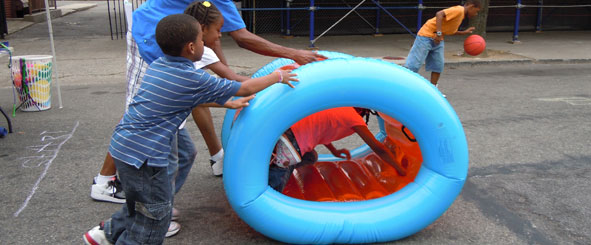Many years ago in the book A Pattern language by Christopher Alexander the idea was presented that for people to use a park on a daily basis it had to be within a 3 minute walk.
A pattern language
He goes on to say that these parks should be 60,000 SF at 1500 foot intervals. Now there is no way that this can be done in today's Manhattan. Curious thing is that this was what we had in the Manhattan of yesterday( and will again occur in the Manhattan once again sometime after between 2018 and 2035.)
Alexander's findings have been corroborated by William H Whyte
Location—How far will people walk to urban parks? “The effective market radius is about three blocks”. link
Distance to parks has also been been cooberated with active recreation useage
A recent multiple-site study of public park and objectively-measured physical activity for adolescent girls in the US shows that park access (the presence and density of parks in local neighborhoods and proximity to neighborhood parks) was associated with higher levels of nonschool moderate-to-vigorous physical activity link
Yesterday
- . In the days before our streets were usurped by automobiles, they were our parks
- . In the days before our streets were usurped by automobiles, they were our parks
 |
| Chasing pigs on 23rd St and 6th ave Circa 1886 from Letters to Phil |

"The New York street has been a play space to children from early times to the present."
From New York, New York by Lawrence Halprin (1968)
"For Most of History, city streets were for everyone. the road was a market,
a playground, a park, and yes a throughfare," The Happy City (p69-70)
Dual
use of city streets as play spaces and for transportation continued
until sometime in the 20th century, when the automobile
industry finally won its decades long battle to to claim our streets
for the exclusive use of automobiles, with humans usage of
streets being relegated to use of crosswalk only . Our high speed
automobile dominated streets have resulted in "over 15,000 pedestrians and cyclists were injured in New York City
traffic in 2012, and 155 were killed",. Link It is with good reason that we "Zebras" have ceded our streets to the "Lions" and "Hyenas"
Today
The NYC Citybench program intends to install 1500 benches throughout the city.

In Hell's Kitchen (above) and Chelsea (below) adding a bench at curbside, transforms a sidewalk normally used for circulation, into a "sidewalk park". These benches cost $2,000 each. Building new centralized parks is expensive. A New York Post article showed the cost of building some parks, the lowest cost was $3.8 million. . Just the renovation of Matthews Palmer playground in Hell's Kitchen will cost $1.8 million dollars. For $200,000, a neighborhood can have 100 decentralized sidewalk parks , scattered throughout the community meeting a good part of the goal of a "park" within 3 minutes walking distance.

The Hanptons Inn Sidewalk park on West 24th St off 6th ave, offers a quiet spot with a garden view
Add a bookcase to a sidewalk park and you have an outdoor reading room
 |
| Revolution Books Sidewalk Park/Outdoor Reading Room, West 26th St off 7th Ave |
Sidewalk park benches are great but they do have limitations. There is no table or moveable seating in a sidewalk bench. The concept of the Parklet, a small park placed in the roadbed and replacing several car parking spots helps get around this limitation while creating the 3 Minute Park,
Parklets
This Pop Up cafe on Sullivan St has no purchase necessary.
Boulevard 41 between 5th and 6th avenues. Over 30 parklets will be placed on this block

Replacing 3 parking spots this Los Angeles parklet combines active and social recreation . Los Angeles intends to install hundreds of parklets. This parklet is reminiscent of the above 1941 Broome Street photo. A parklet generally cost $10,000-20,000.
Through a combination of existing centralized parks, plazas, and privately owned public spaces along with newfangled sidewalk park benches and parklets the goal of a 3 minute park can be achieved not by 2030, but in the near future.

This map shows all the Public outdoor Passive recreation seating locations in Chelsea. It shows that Chelsea now (or will soon) offer a place to sit outdoors within a 3 minute walk of all Chelsea residents with the exception of the small shaded area in south east Chelsea. link
Tomorrow
Driverless Car Video
reduce accident rates by 90%
and
get up to 90% of current vehicles off our streets
If these new cars meet their promise, then the future of our parks will be like our past where our streets will once again be safe they to play in again freeing them to one again be our parks just like the old days.








